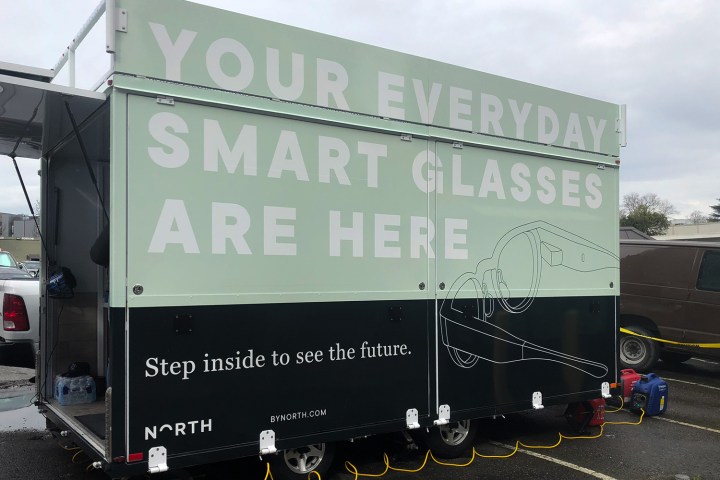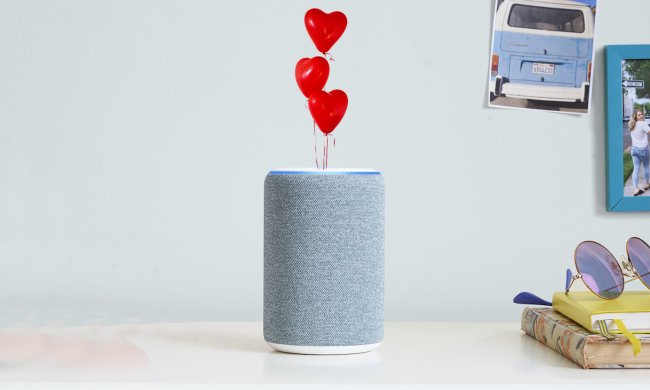
It was a rainy morning in Seattle when I stepped inside a trailer not far from Amazon’s Spheres to try on North’s Focals, smart glasses that show notifications, the weather, and connect with Alexa. The pop-up store’s location in high-tech downtown Seattle was no accident. When I was getting fitted for the glasses, a man wandered up and started asking about how the app he’s developing could possibly pair with the unique wearables. The frames start at $600 — without a prescription — so they’re definitely aimed at techies with money to burn.
North has retail locations in Toronto, Canada and Brooklyn, New York, but it’s taking the trailer on a tour of the West Coast. Although the plastic frames resemble something you might find at Warby Parker, there’s no try-at-home option. You need to see them in person not once, but twice. The first time, North will create a 3D model of your head (using a bunch of cameras) to get your Focals to fit your face. The second time, when the glasses are ready — approximately 10 weeks later — an optician will make sure everything’s perfectly aligned and the display is crisp and clear.
“It’s so precise in terms of the display that it’s really needed,” said Adam Hackney, North’s team lead, about the second fitting. “But it also helps and really supports that whole idea of them being super customized for you.”
The refitting process may not be that unusual for people who normally wear glasses, but it wasn’t until recently that Focals even offered a prescription version ($200 extra, which can be submitted to a vision insurance for reimbursement). Also, waiting several weeks to get prescription glasses is probably a deal-breaker for some. Hackney didn’t have definitive details on how people who were ordering Focals at the trailer that day would actually get their glasses — maybe a second pop-up trailer would swing through Seattle in the coming months? — but he seemed confident they would.
“The fitting also helps and really supports that whole idea of them being super customized for you.”
When I was trying on the tortoise shell Focals ($100 extra), I had to lean close to a mirror to see how the frames looked. “These aren’t just for show,” I said, pointing to my actual glasses. Maybe that’s why I had do some heavy squinting to see the info projected onto the lens (there’s a projected embedded into the right arm). Using a ring with a toggle, I scrolled through message notifications and the weather, and attempted to find a coffee place nearby. Unfortunately, there was a connection issue, so the last part didn’t work.
You can only control the Focals through a combination of the ring and voice commands, and some functions are limited, particular those that require typing. When a text message pops up, there are some automatic prompts that you can use to reply, if you don’t want to use speech-to-text — similar to using CarPlay while driving. There are ways to customize how many alerts you get on your Focals so you aren’t overloaded. (Even though the display is fairly unobtrusive, I’d sooner throw them in the trash than connect them to my Slack notifications, for example.)

At some point during the demo, one member of the North team started talking about reviews of a nearby coffee shop. I automatically turned to follow her gaze. Of course, what she was looking at, I couldn’t see. The information was on her glasses. It was a bit like when you answer, “What?” to someone who turns out to be talking on a Bluetooth earpiece.
It took Warby Parker several years to get retail stores all over the country, but there’s obviously a reason the company felt it was necessary. There are some things people prefer to buy (and try on) in person. Glasses — even if you’re just wearing them for fashion — often need adjusting by a professional. In the case of Focals, that adjustment is mandatory, and because you won’t find Focals as easily as a LensCrafters, fittings and maintenance could be an issue.
Watching someone use the glasses is a bit like answering, “What?” to someone using a Bluetooth earpiece.
Since my visit, North has hit a couple big problems. First, it laid off 150 employees in February, which is a significant cut to its workforce. Then, in response, the Canadian government, which provided $18 million as part of the country’s Strategic Innovation Fund, announced it would be pulling its investment. This puts both product and company’s longevity into question.
The customization process and limited retail options, not to mention price, mean if you get Focals now, you’ll likely be the only one of your friends to have them. If you’re excited about smart glasses, by all means, go and check them out. Just don’t expect to walk away with your pair anytime soon.
Read Digital Trends’ full review of North Focals.




